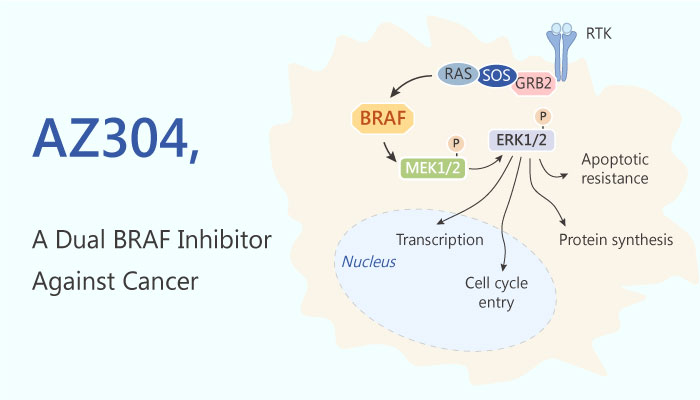Cancer is the most serious disease in the world. Gene mutation always exhibits in many of human cancers, especially oncogenic BRAF mutations. Non-small cell lung cancer, ovarian cancer, leukaemia, gliomas and other malignancies have had BRAF mutations already. Although several BRAF inhibitors are launched to market, we need to find out more to solve different kinds of cancers.
BRAF protein plays an important role in sending signals inside cells and regulating cell growth. BRAF mutation occurs in some human cancers. Thus, it is necessary to find out a BRAF mutation inhibitor. AZ304, a dual BRAF inhibitor, shows potent anti-tumor activity.
So, how does the compound work? Researchers carry out a series of bio-assays to measure its activity.

In cell-free assays, AZ304 potently inhibits wild type BRAF, V600E mutant BRAF and wild type CRAF. The IC50s are 79 nM, 38 nM and 68 nM, respectively. Besides, AZ304 is effective on other kinases, including p38 (IC50, 6 nM), CSF1R (IC50, 35 nM). It shows weak effect on MAP3K7 (IC50, 6400 nM) and CSK (IC50, 7050 nM).
In cellular assays, AZ304 displays significantly anti-tumor activity. AZ304 at 0, 0.1, 1, 10, 100 μM, suppresses the growth of RKO, HT-29, DiFi, and Caco-2 cells in a dose-dependent manner. The GI50s are 4.539 μM, 3.896 μM, 4.987 μM, 1.763 μM at 48 hours, 0.5032 μM, 0.3887 μM, 0.6354 μM, 0.3772 μM, respectively, at 72 hours in these cells.
In animal assays, AZ304 causes reduced tumor growth in mice. What’s more, its anti-tumor effect is enhanced by Cetuximab in mice.
AZ304 is a potent BRAF inhibitor, blocks both wild type BRAF and V600E mutant BRAF activity. It exhibits potent anti-tumor activity. Therefore, it is needful to go on further study about AZ304. Hope it will play an important role in cancer treatment.